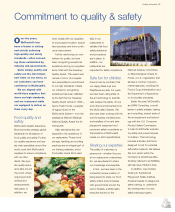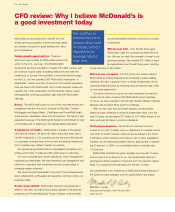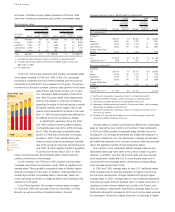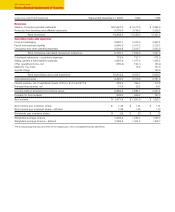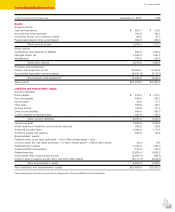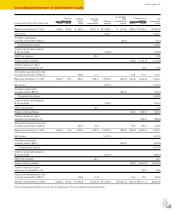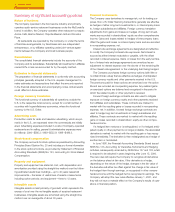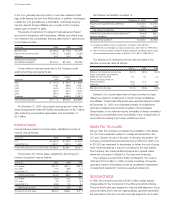McDonalds 2000 Annual Report Download - page 37
Download and view the complete annual report
Please find page 37 of the 2000 McDonalds annual report below. You can navigate through the pages in the report by either clicking on the pages listed below, or by using the keyword search tool below to find specific information within the annual report.
The Company manages its debt portfolio to mitigate the impact of
changes in global interest rates and foreign currency rates by periodi-
cally retiring, redeeming and repurchasing debt, terminating exchange
agreements and using derivatives. The Company does not use deriva-
tives with a level of complexity or with a risk higher than the exposures
to be hedged and does not hold or issue derivatives for trading pur-
poses. All exchange agreements are over-the-counter instruments.
The Company actively hedges selected currencies to reduce
the effect of fluctuating foreign currencies on reported results and
to minimize the cash exposure of foreign currency royalty and
other payments received in the U.S. In addition, where practical,
McDonald’s restaurants purchase goods and services in local cur-
rencies, resulting in natural hedges, and the Company typically
finances in local currencies, creating economic hedges.
The Company’s exposure is diversified among a broad basket of
currencies. At year-end 2000 and 1999, assets in hyperinflationary
markets were principally financed in U.S. Dollars. The Company’s
largest net asset exposures (defined as foreign currency assets less
foreign currency liabilities) at year end were as follows:
Foreign currency exposures
IN MILLIONS OF U.S. DOLLARS 2000 1999
Euro $1,185 $1,059
Canadian Dollars 763 797
British Pounds Sterling 638 669
Australian Dollars 329 394
Mexican Pesos 157 141
Brazilian Reais 115 124
The Company prepared sensitivity analyses of its financial instru-
ments to determine the impact of hypothetical changes in interest
rates and foreign currency exchange rates on the Company’s results
of operations, cash flows and the fair value of its financial instru-
ments. The interest-rate analysis assumed a one percentage point
adverse change in interest rates on all financial instruments but did
not consider the effects of the reduced level of economic activity that
could exist in such an environment. The foreign currency rate analysis
assumed that each foreign currency rate would change by 10% in
the same direction relative to the U.S. Dollar on all financial instru-
ments. However, the analysis did not include the potential impact on
sales levels or local currency prices or the effect of fluctuating curren-
cies on the Company’s anticipated foreign currency royalties and
other payments received in the U.S. Based on the results of these
analyses of the Company’s financial instruments, neither a one per-
centage point adverse change in interest rates from year-end 2000
levels nor a 10% adverse change in foreign currency rates from year-
end 2000 levels would materially affect the Company’s results of
operations, cash flows or the fair value of its financial instruments.
Other matters
Effects of changing prices—inflation
The Company has demonstrated an ability to manage inflationary
cost increases effectively. This is because of rapid inventory turnover,
the ability to adjust menu prices, cost controls and substantial prop-
erty holdings—many of which are at fixed costs and partly financed
by debt made less expensive by inflation.
In hyperinflationary markets, menu board
prices typically are adjusted to keep pace
with inflation, mitigating the effect on
reported results.
Euro conversion
Twelve member countries of the
European Union have established fixed
conversion rates between their existing
currencies (“legacy currencies”) and one
common currency, the Euro. The Euro is
traded on currency exchanges and may be used in certain transac-
tions, such as electronic payments. Beginning in January 2002,
new Euro-denominated notes and coins will be issued, and legacy
currencies will be withdrawn from circulation. The conversion to the
Euro has eliminated currency exchange rate risk for transactions
between the member countries, which for McDonald’s primarily
consists of payments to suppliers. In addition, as we use foreign
currency-denominated debt and derivatives to meet financing
requirements and to minimize foreign currency risks, certain of these
financial instruments are denominated in Euro.
McDonald’s has restaurants located in all member countries and
has been preparing for the introduction of the Euro for the past several
years. The Company currently is addressing the issues involved with
the new currency, which include converting information technology
systems, recalculating currency risk, recalibrating derivatives and
other financial instruments, and revising processes for preparing
accounting and taxation records. Based on the work to date, the
Company does not believe the Euro conversion will have a significant
impact on its financial position, results of operations or cash flows.
Forward-looking statements
Certain forward-looking statements are included in this report. They
use such words as “may,” “will,” “expect,” “believe,” “plan” and other
similar terminology. These statements reflect management’s current
expectations regarding future events and operating performance and
speak only as of March 8, 2001. These forward-looking statements
involve a number of risks and uncertainties. The following are some
of the factors that could cause actual results to differ materially from
those expressed in or underlying our forward-looking statements:
the effectiveness of operating initiatives and advertising and promo-
tional efforts, the effects of the Euro conversion, as well as changes
in: global and local business and economic conditions; currency
exchange (particularly the Euro) and interest rates; food, labor and
other operating costs; political or economic instability in local mar-
kets; competition; consumer preferences, spending patterns and
demographic trends; legislation and governmental regulation; and
accounting policies and practices. The foregoing list of important
factors is not exclusive.
The Company undertakes no obligation to publicly update or
revise any forward-looking statements, whether as a result of new
information, future events or otherwise.
Year in review 35


